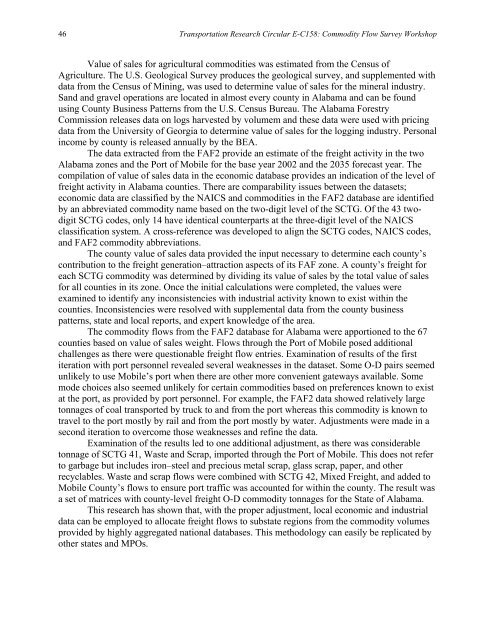E-C158 Cover1 - Center for Transportation Analysis - Oak Ridge ...
E-C158 Cover1 - Center for Transportation Analysis - Oak Ridge ...
E-C158 Cover1 - Center for Transportation Analysis - Oak Ridge ...
Create successful ePaper yourself
Turn your PDF publications into a flip-book with our unique Google optimized e-Paper software.
46 <strong>Transportation</strong> Research Circular E-<strong>C158</strong>: Commodity Flow Survey Workshop<br />
Value of sales <strong>for</strong> agricultural commodities was estimated from the Census of<br />
Agriculture. The U.S. Geological Survey produces the geological survey, and supplemented with<br />
data from the Census of Mining, was used to determine value of sales <strong>for</strong> the mineral industry.<br />
Sand and gravel operations are located in almost every county in Alabama and can be found<br />
using County Business Patterns from the U.S. Census Bureau. The Alabama Forestry<br />
Commission releases data on logs harvested by volumem and these data were used with pricing<br />
data from the University of Georgia to determine value of sales <strong>for</strong> the logging industry. Personal<br />
income by county is released annually by the BEA.<br />
The data extracted from the FAF2 provide an estimate of the freight activity in the two<br />
Alabama zones and the Port of Mobile <strong>for</strong> the base year 2002 and the 2035 <strong>for</strong>ecast year. The<br />
compilation of value of sales data in the economic database provides an indication of the level of<br />
freight activity in Alabama counties. There are comparability issues between the datasets;<br />
economic data are classified by the NAICS and commodities in the FAF2 database are identified<br />
by an abbreviated commodity name based on the two-digit level of the SCTG. Of the 43 twodigit<br />
SCTG codes, only 14 have identical counterparts at the three-digit level of the NAICS<br />
classification system. A cross-reference was developed to align the SCTG codes, NAICS codes,<br />
and FAF2 commodity abbreviations.<br />
The county value of sales data provided the input necessary to determine each county’s<br />
contribution to the freight generation–attraction aspects of its FAF zone. A county’s freight <strong>for</strong><br />
each SCTG commodity was determined by dividing its value of sales by the total value of sales<br />
<strong>for</strong> all counties in its zone. Once the initial calculations were completed, the values were<br />
examined to identify any inconsistencies with industrial activity known to exist within the<br />
counties. Inconsistencies were resolved with supplemental data from the county business<br />
patterns, state and local reports, and expert knowledge of the area.<br />
The commodity flows from the FAF2 database <strong>for</strong> Alabama were apportioned to the 67<br />
counties based on value of sales weight. Flows through the Port of Mobile posed additional<br />
challenges as there were questionable freight flow entries. Examination of results of the first<br />
iteration with port personnel revealed several weaknesses in the dataset. Some O-D pairs seemed<br />
unlikely to use Mobile’s port when there are other more convenient gateways available. Some<br />
mode choices also seemed unlikely <strong>for</strong> certain commodities based on preferences known to exist<br />
at the port, as provided by port personnel. For example, the FAF2 data showed relatively large<br />
tonnages of coal transported by truck to and from the port whereas this commodity is known to<br />
travel to the port mostly by rail and from the port mostly by water. Adjustments were made in a<br />
second iteration to overcome those weaknesses and refine the data.<br />
Examination of the results led to one additional adjustment, as there was considerable<br />
tonnage of SCTG 41, Waste and Scrap, imported through the Port of Mobile. This does not refer<br />
to garbage but includes iron–steel and precious metal scrap, glass scrap, paper, and other<br />
recyclables. Waste and scrap flows were combined with SCTG 42, Mixed Freight, and added to<br />
Mobile County’s flows to ensure port traffic was accounted <strong>for</strong> within the county. The result was<br />
a set of matrices with county-level freight O-D commodity tonnages <strong>for</strong> the State of Alabama.<br />
This research has shown that, with the proper adjustment, local economic and industrial<br />
data can be employed to allocate freight flows to substate regions from the commodity volumes<br />
provided by highly aggregated national databases. This methodology can easily be replicated by<br />
other states and MPOs.

















